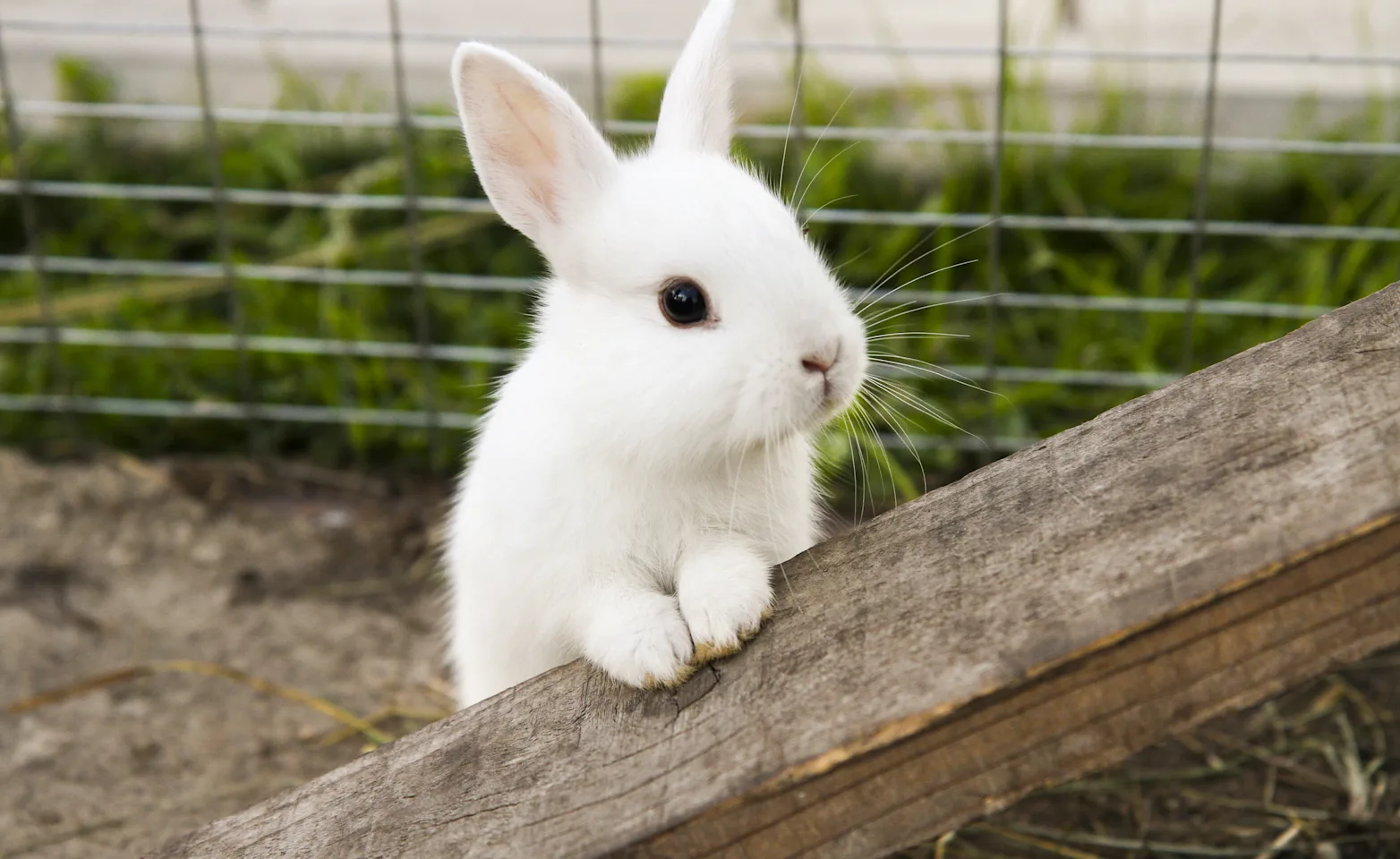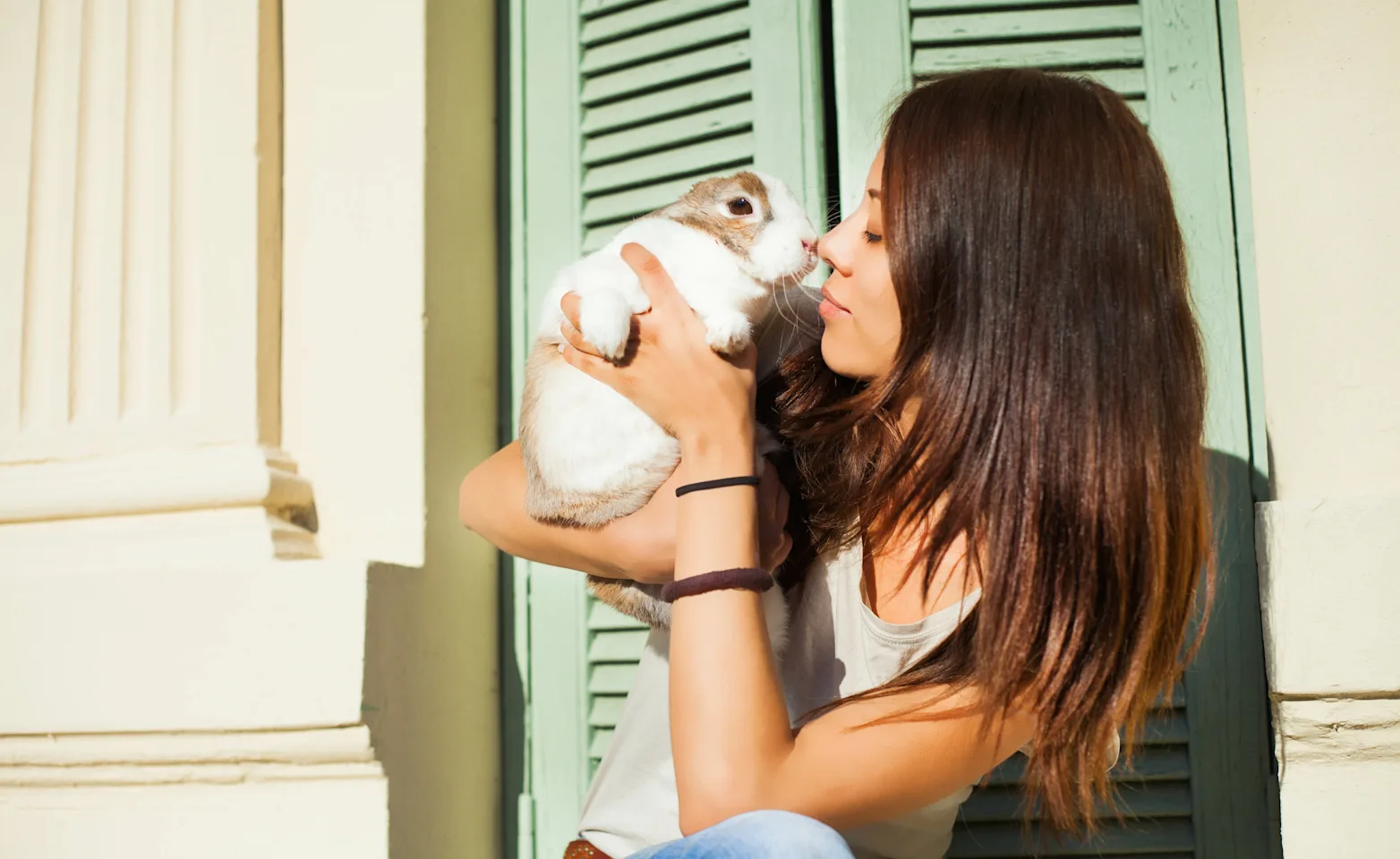Mt. Hood Pet Medical

Rabbit Care

Handling
Rabbits are easily frightened by sounds and movement. Never pick up a rabbit by the ears. Instead place one hand under the chest (behind the front legs) and scoop up the hindquarters with the other hand. Another method is to scoop the rabbit up with your forearm, holding it against your body with your arm underneath, the rabbit’s rear end in the crook of your elbow, and your other hand on top of the rabbit’s shoulders to prevent it from jumping away. Always support the rabbit’s weight from beneath and hold the rear legs securely tucked in; a rabbit may break its back while thrashing if picked up without supporting the rear legs.

Routine Care
Most rabbits are fairly low maintenance. You may need to brush or pluck your rabbit’s fur daily during molting to reduce risk of hairballs blocking the gut. Long haired breeds need regular combing to prevent mats and hairballs. Toenails need trimming every month or so; small dog or cat nail trimmers may be used. Avoid the pink nail base which will bleed if cut. Annual veterinary exams are important in rabbits. Males and females should be spayed or neutered at 5-6 months old to prevent cancer.

Housing
Outdoor rabbit hutches may be used; they need to be sturdy to prevent intrusion by raccoons or other animals, and must provide shelter from wind and rain. A 3- sided shed (1 side open) facing away from the prevailing wind is adequate. Rabbits are cold tolerant and can survive in an unheated hutch if provided with dry draft free conditions and bedding to snuggle into. They are heat sensitive and may die of heat prostration at temperatures over 80-85 F. Provide shade, plenty of water and a frozen milk jug to sit against on hot days, or bring the rabbit indoors. More often rabbits are housed totally indoors, either in a spacious cage or having the run of the house.

Cage Guidelines
If the floor is wire, cover it with thick bedding, or provide a smooth surface (wood or cardboard) to sit on, or the feet will develop sores. If the floor is solid, provide a deep bedding layer to absorb urine and prevent soiling. Straw, hardwood chips (not pine or cedar) or paper bedding are good. A litter box filled with recycled paper or plant pellets may be used by some rabbits. Keep the cage clean, dry and well ventilated. Minimize chewing on metal or hard wood; instead provide cardboard or paper toys (non-inked) to chew and play with.
Small breeds (such as Polish, Dutch & Netherland Dwarf) -- (minimum) 24”x 30”x 18” cage.
Medium breeds (such as New Zealands, Californians, and Satins) -- 30”x 30”x 18” cage.
Giant breeds (such as Flemish Giants and Checkered Giants) -- 48”x 30”x 18” cage.
Pellets
Pellets provide balanced nutrition; hay provides fiber. The diet can be up to 50% pellets with young growing babies or pregnant & nursing females. Babies & breeding females need alfalfa-based pellets containing 16-20% protein. With non-breeding adults use a 12-14% protein timothy pellet, as 15-25% of the diet (adjust amount to maintain proper weight). Approximate pellet feeding guidelines are:
Small breeds: 2 oz. daily (weight, not volume)
Medium breeds: 5-6 oz. daily
Large breeds: 6-8 oz. daily.
Avoid mixes with seeds, nuts or dried fruits which may cause bowel problems and obesity. Always use some pellets in the diet; without these the risk of rickets and other nutritional problems is higher. A brand with superior adult formulation is Oxbow Bunny Basics-T (timothy based pellets). This has less calcium and protein than many standard pellets. A heavy bowl or metal hopper feeder will minimize food spillage & soiling.
Hay
A lean grass hay should be fed free choice; timothy hay and oat hay are best for babies & adults. Alfalfa hay is unnecessary if unlimited alfalfa pellets are given to pregnant and juvenile rabbits. Alfalfa is too rich for non-pregnant adult rabbits and can cause GI upsets, obesity and bladder stones. Ideally put hay in a hopper or wire bin on the cage wall, to minimize scattering and soiling of the hay on the cage floor. Wet and moldy food can be toxic.
Vegetables
Veggies may be fed as 10-15% (or less) of the diet; more may cause bowel upsets, especially in older rabbits. The rabbit digestive tract is adapted for eating mostly grasses and high fiber plants unsuitable for human consumption; many vegetables humans consume are too rich to feed to rabbits. Leafy greens such as lettuce, spinach, dandelions, blackberry leaves, grasses, cilantro, carrot tops, and parsley are the best tolerated. Avoid foods high in sugar (fruits, carrots, tomatoes, peppers, corn, etc.); also limit items high in protein (seeds, nuts, oats, grains, beans, etc).
Items to Avoid
Avoid veggies in the cabbage family (cabbage, broccoli, Brussels sprouts, cauliflower, kale, bok choy) as they may cause gas production and bloating. Avoid sweet treats such as yogurt drops. FEED NO MEAT OR DAIRY PRODUCTS. Feeding a few veggies daily is safer than giving a lot once weekly; the rabbit bowel dislikes sudden changes, and a rabbit may also overeat veggies if provided large amounts at one time. Introduce new foods gradually to see how they are tolerated; avoid any foods that cause diarrhea or appetite loss.
Water
Provide clean water at all times; change it daily. In cages water 2 bottles are best as rabbits tend to spill or soil water bowls. Check the bottle spout periodically to ensure it doesn’t plug.
SKIN MITES (CHEYLETIELLA)
These are common and may produce no symptoms for months or years. The first sign is often a patch of flaky “dandruff” over the shoulder area (on the back), which may slowly spread. Itching and hair loss occur in severe cases. Treatment with ivermectin or selamectin is effective; treat for 6-8 weeks.
EAR MITES
These are small mites which live in the ear & produce dry crusty debris in the canal. Symptoms may be absent, or may include head shaking, pawing at the ears, or ears held lower than normal. Treatment with oral Ivermectin usually eliminates the mites; stubborn cases may need ear cleaning and ear drops.
“SNUFFLES”
This is a respiratory disease, usually caused by Pasteurella or Staph bacteria. These may be carried for months or years with no symptoms. Snuffles is highly contagious, and can occasionally be fatal, especially in very young animals. Cats commonly carry Pasteurella without symptoms; avoid catrabbit contact! Rabbits living with cats can now be vaccinated yearly for Pasteurella. Symptoms in rabbits are sneezing, runny eyes or nose, congested breathing, or weight loss. This disease may progress slowly, or can rapidly cause death. Prompt treatment with antibiotics is recommended when symptoms are present. Infections are life-long but can usually be well controlled.
INNER EAR INFECTION (HEAD TILT, WRY NECK)
This is usually caused by Pasteurella or Staph bacteria, and can occur secondary to respiratory infection. Signs are acute dizziness & balance loss; the rabbit’s head may be twisted back or sideways. Prompt veterinary care and antibiotics are needed. A less common disease with similar signs is Encephalitozoon cuniculi, a parasite which can affect the brain. It usually causes milder and more gradual symptoms.
UTERINE CANCER
Very common in aging female rabbits (over 3 years old) if not spayed; up to 80% of older females may get this disease! Often fatal if not detected early, uterine cancer is easily prevented by spaying non-breeding females at 5-6 months old. Uterine tumors that haven’t spread may be cured by spaying as well.
WOOL BLOCK OR HAIRBALLS
Blockages of the digestive tract can be due to impactions of food and hair in the stomach or bowel. This occurs more often on low roughage diets (e.g. no hay) and during molting. Long haired rabbits are especially at risk. A rabbit may swallow large amounts of hair when grooming; brush or pluck fur daily during Spring and Fall molting to minimize buildup of hair in the stomach. Stomach hairballs (actually a congealed mix of food and hair) cause slow appetite loss, and decrease in size & number of fecal pellets. A veterinary exam can usually detect a hairball in the stomach. Medical 3 treatment is often successful: heavy fluid intake, stomach massage, and Reglan (metoclopramide) often help empty the stomach. Avoid pineapple juice or papaya, as these are high in sugar and can cause diarrhea, and are not effective at removing hairballs. Probiotics (acidophilus) may minimize diarrhea and bloating while the rabbit is stressed & fasting. Occasionally a small hairball escapes the stomach but blocks the intestine; these patients become painful, weak, and progress into shock & death within 4-12 hours. Emergency surgery is the only option.
DENTAL DISEASE
Rabbits have a variety of tooth problems, the most common being malocclusion and tooth abscesses. Malocclusion is the improper alignment of teeth resulting in tooth overgrowth. Rabbit teeth grow constantly. When incisors (front teeth) are misaligned they can’t wear down on the opposing teeth and can grow to extreme lengths. Gnawing on hard objects (wood, metal) doesn’t help wear down the incisors, and may actually damage the teeth, helping to create a malocclusion. Molars (back teeth) may also overgrow due to misalignment, or due to tooth infection and pain which prevents normal chewing. Molars are worn down partially by chewing abrasive foods (pellets & hay). Symptoms of tooth overgrowth include weight loss, appetite loss, salivation, oral odor, and tooth grinding. Treatment includes trimming the teeth to proper length and correcting any underlying problems.
DYSBIOSIS, ILEUS, & ENTEROTOXEMIA (BOWEL DISEASE)
These are intestinal upsets caused by imbalances of intestinal bacteria, with resulting overgrowth of harmful bacteria such as Clostridium. These can produce toxins, which may lead to loss of gut motility, gas, cramping, and bloating. Severe cases lead to shock and death. Disruption of the intestinal bacteria is usually the underlying problem; common causes include sudden diet changes, sugary items like fruit, high protein items like oats and alfalfa, low roughage diets lacking in hay, antibiotic usage (especially penicillins), or other diseases and stress (especially if fasting occurs). Mild bowel upsets may cause slight stool softening; severe cases have appetite loss, sometimes watery or mucoid diarrhea (or no stools), and severe weakness. Treatment includes bowel stimulants (Reglan) to help bowel movement, and bacterial supplements (milk-free acidophilus, veterinary probiotics, or healthy rabbit fecal slurry) to reload the bowel with harmless bacteria. Banamine (or meloxicam) can reduce pain and cramps. Hypothermic rabbits need warm injected fluids and heat provided. Force-feeding roughage may help. Toxin binding drugs (Toxiban) may help prevent absorption of bowel toxins into the body. Kaolin-pectin and blackberry leaves may firm the stools. Antibiotic usage is usually avoided. Severe cases can progress to coma and death within hours. If your rabbit is lethargic, not eating, has diarrhea, or acts uncomfortable or “hunched up,” seek veterinary care immediately! Feed a high roughage diet (hay, pellets, minimal treats) to help avoid this disease.
RABBIT HEMORRHAGIC DISEASE
Rabbit hemorrhagic disease is a fatal disease in rabbits and is classified as a foreign animal disease in the United States. RHDV2 does not impact human health. The RHDV2 virus is very resistant to extreme temperatures. It can be spread through direct contact or exposure to an infected rabbit’s excretions or blood. The virus can also survive and spread from carcasses, food, water, and any contaminated materials. People can spread the virus indirectly by carrying it on their clothing and shoes. For more information, please read the USDA's Factsheet on RHDV2, or call The Center for Bird and Exotic Medicine (CBEAM) directly at 425-486-9000 for a possible vaccine
